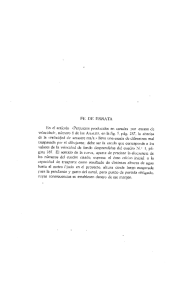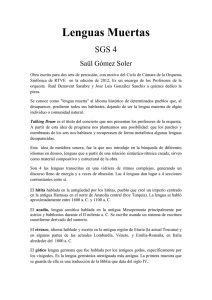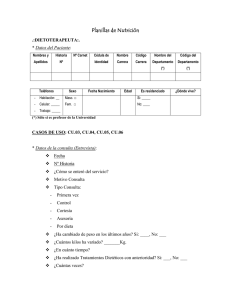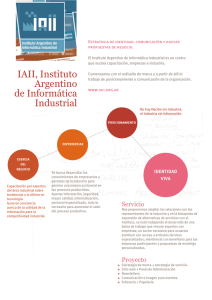El Monte de las Ánimas - Andrés Valero Castells
Anuncio
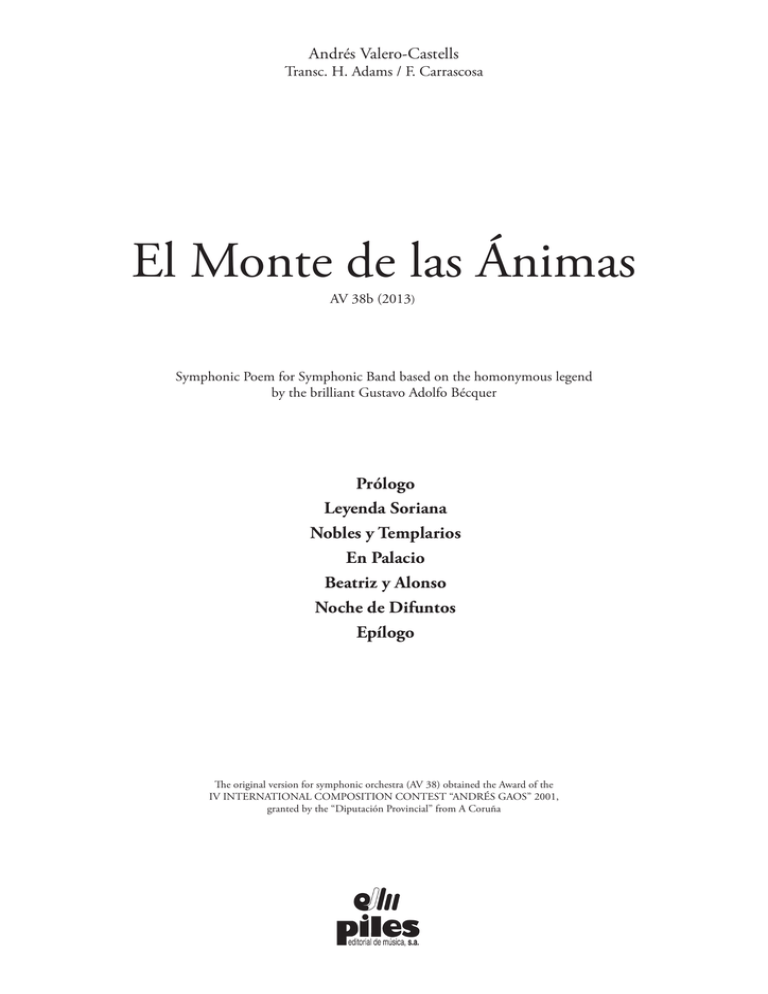
Andrés Valero-Castells Transc. H. Adams / F. Carrascosa El Monte de las Ánimas AV 38b (2013) Symphonic Poem for Symphonic Band based on the homonymous legend by the brilliant Gustavo Adolfo Bécquer Prólogo Leyenda Soriana Nobles y Templarios En Palacio Beatriz y Alonso Noche de Difuntos Epílogo The original version for symphonic orchestra (AV 38) obtained the Award of the IV INTERNATIONAL COMPOSITION CONTEST “ANDRÉS GAOS” 2001, granted by the “Diputación Provincial” from A Coruña Extracto del acta del jurado del Premio: …resalta la seriedad del lenguaje y la alta profesionalidad de su escritura, así como el uso de la estructura dramática del sonido… Sobre el estreno de la obra con la Orquesta Sinfónica de Galicia la crítica dijo: ….La partitura de Valero posee una enorme potencialidad para sugerir imágenes mediante la utilización de una colorida paleta instrumental….el público tributó con certero instinto un caluroso homenaje al autor, muy por encima de lo habitual en estrenos de partituras contemporáneas: Valero hubo de saludar hasta tres veces, una desde el palco escénico… Julio Andrade Malde (La Opinión, A Coruña, 1-3-03) ….La orquestación es realmente eficaz en todo el transcurso de la obra….sus anunciados 22 minutos son seguramente los mejor aprovechados que se han estrenado últimamente por aquí… Julián Carrillo (Mundoclasico.com, 5-3-03) ….Se acabaron los jeroglíficos, la música que se dirige al intelecto y desprecia las emociones, Valero ha captado el nuevo mensaje. Las ideas cobran vida en unos pentagramas que buscan seducir con el hábil empleo del ritmo y el caramelo de la melodía…El edificio sonoro es sólido pero la estructura no se sobrepone a la belleza de una música que busca ese placer…Al público le gustan las caricias, por eso Valero fue ovacionado largamente… César Wonenburger (La Voz de A Coruña, 28-2-03) ….Podría dividirse en 2 secciones: la 1ª marcada por un claro tinte de música tradicional, y la 2ª en la que surge una eclosión sonora, un estruendo apabullante... Fue muy aplaudido el autor –joven- que hubo de salir al escenario a saludar… Antonio Buján (El Ideal Gallego, 1-3-03) ….”El Monte…”, de gran intensidad y expresividad, con momentos realmente hermosos…. Miguel Ángel Nepomuceno (Diario de León, 1-3-03) Sobre el estreno de la versión para banda sinfónica, el 22 de agosto de 2003: ….Destacó el estreno de “El Monte...”…abrió un lenguaje nuevo para la música de banda…ha dejado una gran huella en los que estuvieron allí… Vicente Porta (Revista Música y Pueblo, nº120, sept-oct 2003) ****** Extract from the official report of the Prize judges: …it is remarkable for the seriousness of its musical language and the high professional standard of the writing, as well as the use of dramatic sound structure… On the first performance of the work by the Orquesta Sinfónica de Galicia [Galicia Symphony Orchestra], the critics said: …Valero’s score has a tremendous power to evoke images through the use of a colourful instrumental palette… the audience rightly rewarded the composer with an enthusiastic ovation, far beyond the usual response to contemporary scores: Valero had to take three bows, one of them on stage… Julio Andrade Malde (La Opinión, A Coruña, 1-3-03) …The orchestration is really effective throughout the whole piece… the 22 minutes it lasts, according to the programme, were probably the best spent 22 minutes of any first performance held here recently… Julián Carrillo (Mundoclasico.com, 5-3-03) …No more cryptic puzzles, music for the intellect that disregards feeling. Valero has picked up the new message. The ideas come to life in a score which seeks to seduce us with its skilful use of rhythm and honeyed melody… The edifice of sound is solid, but the structure does not outweigh the beauty of the music, designed to create that pleasure… The audience likes being caressed, and for this Valero received a prolonged ovation… César Wonenburger (La Voz de A Coruña, 28-2-03) ….It could be divided into two sections, the first marked by a clear vein of traditional music, and the second with a tremendous outpouring of sound, an overwhelming explosion… The composer was loudly applauded by the (young) audience, and had to come out on stage and take a bow… Antonio Buján (El Ideal Gallego, 1-3-03) ….“El Monte…”, a highly intense and expressive work, with moments of real beauty… Miguel Ángel Nepomuceno (Diario de León, 1-3-03) (on the first performance of the version for symphonic band, on 22 August 2003) ....The high spot was the first performance of “El Monte...”…it initiated a new language for band music… and made a deep impression on those who were there… Vicente Porta (Revista Música y Pueblo, nº120, sept-oct 2003) COMENTARIO “El Monte de las Ánimas” AV 38, es una pieza orquestal que responde al planteamiento de poema sinfónico, puesto que se basa en la leyenda homónima del genial Gustavo Adolfo Bécquer. Más allá de servir como simple pretexto programático, la historia literaria ofrece al lector una serie de sugerentes situaciones, estados de ánimo, y sensaciones psicológicas, que hacen posible un planteamiento musical por encima de lo puramente descriptivo. Además, la narración está plagada de detalles sonoros (como el tañer de las campanas), que lógicamente son aprovechados. Digamos más bien que se trata de una literatura muy “musical”, lo cual no puede más que estimular el proceso de composición. Formalmente la obra, de unos 22 minutos de duración, está estructurada en siete partes: prólogo, leyenda soriana, nobles y templarios, en palacio, Beatriz y Alonso, noche de difuntos y epílogo. El lenguaje y las técnicas utilizadas a lo largo de la obra resultan bastante diversas, por estar supeditadas al fin último, que en este caso sería el de contar, evocar o sugerir al oyente una historia con sonidos. A pesar de esta multiplicidad de recursos, la obra tiene gran cohesión por el uso estratégico de ciertos elementos. En cuanto a la orquestación, destaca la sección de percusión, abundante en recursos humanos e instrumentales, no debido a una búsqueda de fácil espectacularidad, sino por la inmensa capacidad y diversidad tímbrica que ofrece esta sección. La presente versión para banda sinfónica, realizada por Henrie Adams y Francisco Carrascosa, con el beneplácito del autor, fue estrenada el 22 de agosto de 2003 en el emblemático concierto “Mano a Mano” de Buñol, en el auditorio de San Luis, a cargo de la Banda Sinfónica de La Artística de Buñol, bajo la dirección de Henrie Adams. La primera grabación discográfica de la obra fue realizada por la Banda Sinfónica de la FSMCV, en el Palau de la Música de Valencia, bajo la dirección de Henrie Adams, para el prestigioso sello holandés World Wind Music. El Autor ****** ABOUT THE WORK “El Monte de las Ánimas” (“The Spirit’s Mountain”) AV 38, is a symphonic poem, based on the homonymous legend by the brillant Gustavo Adolfo Bécquer. Beyond the programmatic pretext, the literary story offers to the lector various suggestive situations, different states of mind, and psychological sensations, that makes possible to obtain a musical outlining above the purely descriptive. Moreover, the narration is plenty of “sounds” (like the chimes playing) that obviously was very useful. We could say that this is a very “musical” literature, which can not do other thing than stimulate the composing process. Formally the work, which duration is about 22 minutes, is divided in seven parts: prólogo, leyenda soriana, nobles y templarios, en palacio, Beatriz y Alonso, noche de difuntos, y epílogo. The idiom and the techniques used during the work are quite diverse, being subordinated to the final purpose, which would be in this case the telling, evocating, or suggesting to the listener a story with sounds. In spite of this multiplicity, the work is very coherent thanks to a strategic use of certain elements. Concerning the instrumentation, the percussion section is very prominent, abundant in instruments and players. This is not the result of an easy looking for something spectacular, but of the immense capacity and richness of timbres that offers this section. This version for symphonic band, produced with the composer’s approval by Henrie Adams and Francisco Carrascosa, was first performed on 22 August 2003 at the traditional “Mano a Mano” (“Head to Head”) concert in Buñol, in the San Luis auditorium, by the Banda Sinfónica de La Artística de Buñol conducted by Henrie Adams. The first recording of the work was made by the Banda Sinfónica de la FSMCV (Symphonic Band of the Federation of Music Societies of the Valencian Community) at the Palau de la Música in Valencia, with Henrie Adams conducting, for the prestigious Dutch label World Wind Music. The composer http://www.andresvalero.com Instrumentación -Flautín 1, 2 -Flauta 1, 2 -Oboe 1, 2 -Corno Inglés -Fagot 1, 2 -Contrafagot -Requinto (Mib) -Clarinete 1, 2, 3 (Sib) -Clarinete Bajo (Sib) -Saxofón Alto 1, 2 -Saxofón Tenor 1, 2 -Saxofón Barítono -Trompa 1, 2, 3, 4 (Fa) -Trompeta 1, 2, 3 (Do) -Trombón 1, 2, 3 -Bombardino 1, 2 (Do - Sib) -Tuba 1, 2 (Do - Sib) -Violoncello -Contrabajo -Piano -Arpa -Percusión 1º, 2º, 3º, 4º, 5º, 6º, 7º (*) (*) -Perc. 1: -Perc. 2: -Perc. 3: -Perc. 4: -Perc. 5: -Perc. 6: -Perc. 7: Timbales (5), Plato suspendido (crash grande) Vibráfono, Pandereta, Yunque, Carraca, Aeoliófono, Tom toms (4) Campanas (D, F, D, F), Barreño con agua, Caja clara, Triángulo agudo, Cadenas Campanas (G, Bb), Campanas fuera del escenario (C, Db), Lira, Xilófono, Tablas de lija, Tom tom grave, Temple blocks (2) Campanas (E, Ab), Redoblante, Palo de lluvia, Cortina de bambú Platos de choque, Platos suspendidos (ride, crash medio), Látigo, Triángulo grave, Cortina de metal, Bombo pequeño Tam tams (agudo, medio), Bombo grande, Bombo pequeño Notas: -El Perc. 6 y el 7 pueden utilizar el mismo Bombo pequeño. -El Tom tom del Perc. 4, será más grave que el más grave de los 4 del Percu. 2. -El Pl. susp. del perc. 1 se colocará invertido sobre el parche del Timbal grave. -Las Cadenas del Perc. 3 se moverán sobre una plancha metálica. -El Yunque del Perc. 2 se tocará con martillos de metal -Se utilizará una Caja clara pequeña, a ser posible. -Todas las Campanas (tubulares si es posible) pertenecerán a un solo campanófono, utilizando varios soportes (no importa el pedal de apagado, porque siempre se dejarán sonar). -Las Campanas fuera del escenario se colocarán lo más cerca posible del Perc. 4. -Para los efectos de estereofonía de las Campanas, es muy importante respetar la siguiente colocación en el escenario: --Percu. 4º---Percu. 7º---Percu. 6º---Percu. 3º---Percu. 2º---Percu. 1º---Percu. 5º-Director Instruments list -Piccolo 1, 2 -Flute 1, 2 -Oboe 1, 2 -English Horn -Bassoon 1, 2 -Contrabassoon -Eb Clarinet -Bb Clarinet 1, 2, 3 -Bb Bass Clarinet -Alto Saxophone 1, 2 -Tenor Saxophone 1, 2 -Baritone Saxophone -Horn in F 1, 2, 3, 4 -C Trumpet 1, 2, 3 -Trombone 1, 2, 3 -(C - Bb) Euphonium 1, 2 -(C - Bb) Tuba 1, 2 -Violoncello -Double Bass -Piano -Harp -Percussion 1, 2, 3, 4, 5, 6, 7 (*) (*) Perc. 1 : Perc. 2 : Perc. 3 : Perc. 4 : Perc. 5 : Perc. 6 : Perc. 7 : Timpani (5), Suspended Cymbal (Big Crash) Vibraphone, Tambourine, Anvil, Rattle, Wind Machine, Tom-Toms (4) Chimes (D, F, D, F), Earthenware tub with water, Snare Drum, Triangle (High), Chains Chimes (G, Bb), Chimes off-stage (C, Db), Glockenspiel, Xylophone, sandpaper sheets, Low Tom-Tom, Temple Blocks (2) Chimes (E, Ab), Side Drum, Rain Staff, Bamboo Curtain Pair of Cymbals, Suspended Cymbals (Ride, Medium Crash), Whip, Low Triangle, Barchimes, Little Bass Drum Tam Tams (High, Medium), Big Bass Drum, Little Bass Drum Note: -Perc. 6 & 7 can use the same Little Bass Drum -The Tom-Tom of Perc. 4 will be lower than the lowest one of Perc. 2. -The Suspended Cymbal of perc. 1 is to be put inverted upon the Low Timpani -The Chains of Perc. 3 will be moved upon a metal plate -The Anvil of Perc. 2 will be played by metal hammers -If possible, use a little snare drum -All Tubular bells (Chimes) can proceed of the same Set, using different supports (Always let vibrate the Chimes, so you don’t need a pedal. -The chimes off-stage are situated as near as possible of Perc. 4 -To obtain the stereophonic effects of the Chimes, it’s very important to respect the following situating on stage : Perc. 4 —- Perc. 7 —- Perc 6 —- Perc. 3 —- Perc. 2 —- Perc. 1 —- Perc. 5 Conductor
